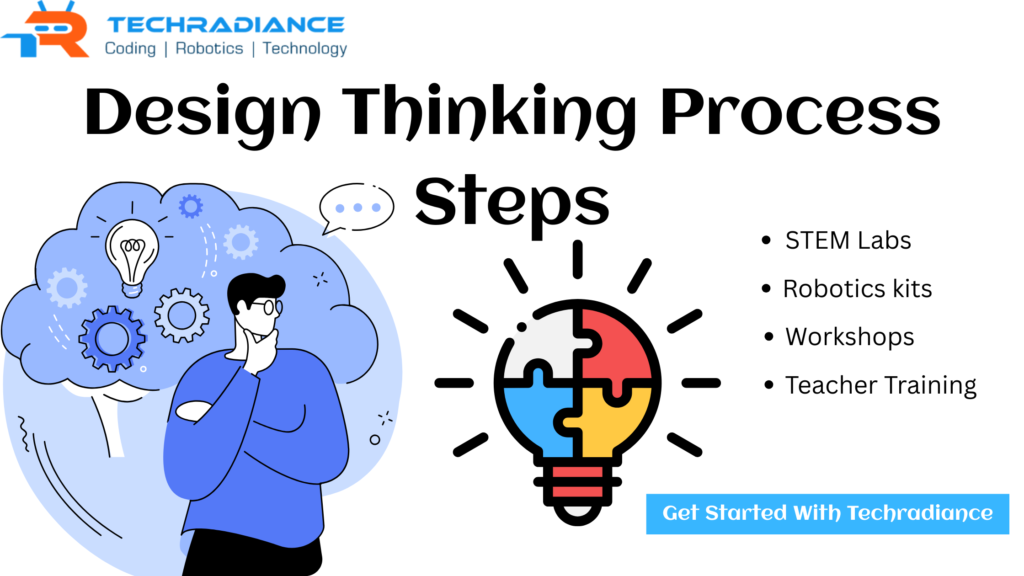Students need more than just books and exams to keep up with the fast-changing world. Students need to be able to solve problems and come up with new ideas. The Design Thinking Process can help. It is now being used by many IB schools to make learning fun and more real.
Learn how Techradiance helps IB schools implement the Design Thinking Process in their classrooms.
What is the Design Thinking Process?
The Design Thinking process is an innovative way to solve issues. It encourages people to come up with new, useful ideas. This process isn’t just for adults. Even children can use and learn it.
It is a method that involves a series of steps to help you understand problems, come up with solutions, and then test and improve them.
Why Do IB Schools Use the Design Thinking Process?
The IB school wants its students to:
- You can also check out our Creative Ideas
- Curious
- Problem solvers are good problem-solvers
- Prepared for the future
In order to do so, they employ the Design Thinking Process when teaching. This method allows students to learn through doing. Students talk, build, test, and improve. It makes learning fun and more useful.
Students feel proud about their work when they solve real problems in a smart way.
Design Thinking Process Steps Explained

We’ll look at the Design Thinking Process Steps. Here are five steps that will help you think like a designer.
| Step | Name | Easy Meaning |
| 1 | Empathize | Understanding how people feel about themselves and the problems they face |
| 2 | Define | What is the problem? |
| 3 | Idea | Try to come up with many different solutions for the same problem |
| 4 | Prototype | Create a miniature or model of the best idea you have |
| 5 | Tests | Test the model to see what works and then improve it |
Each step is crucial. The Design-Thinking Methods can be used in any order, but depending on the circumstances, they may need to change.
Real-Life Design Thinking Process Example in an IB School
We’ll look at a simple Design Thinking Process Example that will help you understand how this works in schools.
The playground at the school gets too hot in summer:
- Empathize: Students can ask their teachers and peers about the effects of heat on them.
- Define. They discover the problem: Children can’t go outside to play on hot days.
- Ideate: They come up with many ideas, such as putting up tents, planting trees, or creating shaded areas.
- Prototype– They create a small cardboard model of a shaded playing zone.
- Test: They present it to other people, get feedback, and then improve the design.
The Design Thinking Process is used to help students solve real-world problems.
How Techradiance Helps Schools Use Design Thinking
Techradiance helps schools bring their ideas to life. They teach this process to students in IB schools through:
- STEM Labs
- Robotics kits
- Workshops
- Teacher Training
Their support allows schools to transform classrooms into laboratories where children can think, build, and test.
Techradiance holds design challenges, where students compete using the design thinking process steps to solve interesting problems.
Design Thinking Methods in the IB Curriculum
They use design thinking methods in every aspect of learning. In every aspect of their learning, they use design thinking methods. This is how it works:
1. Learning Through Stories
Teachers start with a story. The story might be “A family lives in a village that lacks clean drinking water.” Then, students would work together using the five Design Thinking Process Steps to come up with solutions.
2. Project-Based Learning
Students can create water filters, intelligent bags, or small robots. They can learn math, science, and art all at once with these projects.
3. Think Together
Asking questions such as:
- Why is this a problem?
- Who is affected by this problem?
- What can we do?
These questions will lead you to innovative thinking and creativity.
4. Testing and Improving
Students test their models or projects in class after creating them. The students ask for their teacher’s and friends’ opinions. They then improve it based on the feedback. This step is crucial in the Design Thinking process.
Subjects That Use Design Thinking in IB Schools
Design Thinking Method is not limited to computers and science. This process can be applied to many subjects.
- Science: Solving real-world problems, such as waste management.
- English: Write stories that are based upon problems and solutions.
- Math– Budgeting for student projects
- Art: Designing posters and displays.
- Social Studies – Building ideas to help the community
Design Thinking Builds Life Skills
Students who use the Design Thinking Process will learn life skills such as:
- Teamwork is about working together and valuing different ideas
- Creativity is about thinking in new ways
- Leadership: Guiding group projects
- Communication: Sharing your ideas clearly
- Confidence: feeling proud of your work
They can use these skills at school, at home, and for future employment.
Design Thinking Activities for Students
IB schools create simple activities that teach design thinking. Here are a few fun examples:
1. How to Build a Better Backpack
Students consider the problems they have with their schoolbags: too heavy, not enough space, or difficult to carry. They used Design thinking methods to create a new version.
2. Classroom Cleaning Robot
Students can build a robot that will clean the classroom floor using Techradiance’s Robotics kit.
3. Upgrade the lunch menu
Students discuss lunch with their friends and teachers. They then design a healthier, more delicious menu using the Design Thinking process.
The activities are designed to make learning fun and encourage real-world thinking.
Benefits of the Design Thinking Process in IB Schools
Some of the most important benefits are:
- This new interactive method of learning makes learning fun and exciting
- Students can solve real-world problems
- Enhances creativity and critical thinking
- Prepare students for the future
- Respect and teamwork are encouraged
The IB Schools are convinced that smart children are not just those with high scores but also those who can imagine and create new things to improve the world.
Final Thoughts
The Design Thinking Process helps students become smarter, more confident, and better prepared for life in the real world. Learning is more than just books in IB schools. Think with your mind, feel with your heart, and create with your hands.
Students can solve real-world problems using the Design Thinking Process Steps with support from companies such as Techradiance.
These students will not only get good jobs in the future–they’ll create them, build businesses, and make the planet a better place.
Next time your child asks, “Can I create something useful ?”-just smile and say “Use Design Thinking!
For for information , Contact us
Frequently Asked Questions (FAQs)
Q1. What is the Design Thinking Process in easy words?
By thinking, building, and testing ideas, it is easy to solve problems
Q2. Can small kids understand the Design Thinking process?
Yes! Students in primary school can learn this through games, stories and projects.
Q3. How does Techradiance support IB schools?
Techradiance offers schools robotics kits and workshops that help students to use the Design Thinking process creatively.
Q4. Why do IB schools love the Design Thinking method?
It helps students to think more clearly, solve real-world problems, and enjoy learning.

